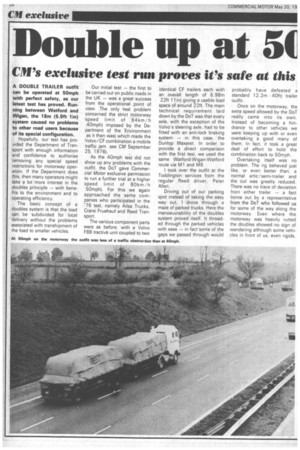Double up at 5( nph
Page 30

Page 31

If you've noticed an error in this article please click here to report it so we can fix it.
CM's exclusive test run proves it's safe at this
A DOUBLE TRAILER outfit can be operated at 50mph with perfect safety, as our latest test has proved. Running between Watford and Wigan, the 18m (5.9ft 1in) system caused no problems to other road users because of its special configuration.
Hopefully, our test has provided the Department of Transport with enough information and confidence to authorise removing any special speed restrictions for motorway operation. If the Department does this, then many operators might take a lot more interest in the doubles principle -with benefits to the environment and to operating efficiency.
The basic concept of a doubles system is that the load can be subdivided for local delivery without the problems associated with transhipment of the load to smaller vehicles.
Our initial test -the first to be carried out on public roads in the UK -was a great success from the operational point of view. The only real problem concerned the strict motorway speed limit of 64km / h 40mph) imposed by the Department of the Environment as it then was) which made the Volvo/CF combination a mobile traffic jam ,see CM September 25, 1976).
As the 40mph test did not show up any problems with the outfit, the DoT gave Commercial Motor exclusive permission to run a further trial at a higher speed limit of 80km lh 50mph). For this we again approached the same companies who participated in the '76 test, namely Ailsa Trucks. Crane Fruehauf and Reed Transport.
The various component parts were as before, with a Volvo F88 tractive unit coupled to two identical CF trailers each with an overall length of 6.98m 22ft 11 in) giving a usable load space of around 22ft. The main technical requirement laid down by the DoT was that every axle, with the exception of the Volvo's steering axle, had to be fitted with an anti-lock braking system -in this case, the Dunlop Maxaret, In order to provide a direct comparison with the first test, we used the same Watford-Wigan-Watford route via M1 and M6.
I took over the outfit at the Toddington services from the regular Reed driver, Peter Allen.
Driving out of our parking spot instead of taking the easy way out, I drove through a maze of parked trucks. Here the manoeuvrability of the doubles system proved itself. It threaded through the parked vehicles with ease -in fact some of the gaps we passed through would probably have defeated a standard 12.2m 40ft) trailer outfit.
Once on the motorway, the extra speed allowed by the DoT really came into its own. Instead of becoming a hindrance to other vehicles we were keeping up with or even overtaking a good many of them. In fact, it took a great deal of effort to hold the combination back to 50mph.
Overtaking itself was no problem. The rig behaved just like, or even better than, a normal artic/semi-trailer and the cut was greatly reduced. There was no trace of deviation from either trailer -a fact borne out by a representative from the DoT who followed us for some of the way along the motorway. Even where the motorway was heavily rutted the doubles showed no sign of wandering although some vehicles in front of us, even rigids,
.did seem to pick up on the ruts.
During our test run we had no occasion to make a fullpressure braking stop although at one point we did need to stop fairly quickly. However, the outfit slowed and stopped under full control all the time.
The overall time taken was 3 hours 57 minutes — nearly an hour quicker than our first test.
Unlike our previous test, one of Reeds F88s took one of the trailers away for local distribution while the second was unloaded at the Wigon depot. This, of course, would probably not be the way to run a doubles in practice.
The loaded traders would normally be taken by smaller units to their final destination while the larger tractive unit would pick up two more ready loaded trailers for the return run. For our return trip the trailers, which had carried printing paper rolls up, were re-loaded, one with waste paper and the other with paint — this proving the versatility of the system.
To sum up this latest run is rather difficult. The DoT still wants operators to run doubles outfits for some time -waiting, one suspects, for something to happen.
The Department is still very conscious that our test was carried out under ideal conditions, by a respected operator and with the technical back up of Volvo, CF and Dunlop.
It says that actual service conditions are different and, of course, operators vary.
While agreeing with this it seems to me that the "cowboys': of the haulage industry are unlikely to be queuing up to buy a doubles outfit. They wouldn't have the necessary warehousing points or distribution facilities. No, it's going to be own-account operators who will use the system to best advantage.
With CF engineers able to reduce the weight of the trailers and dolly to give a payload of around 21.3 tonnes 21 tons) the doubles could make a lot of sense.
• Stephen Gray




























































































